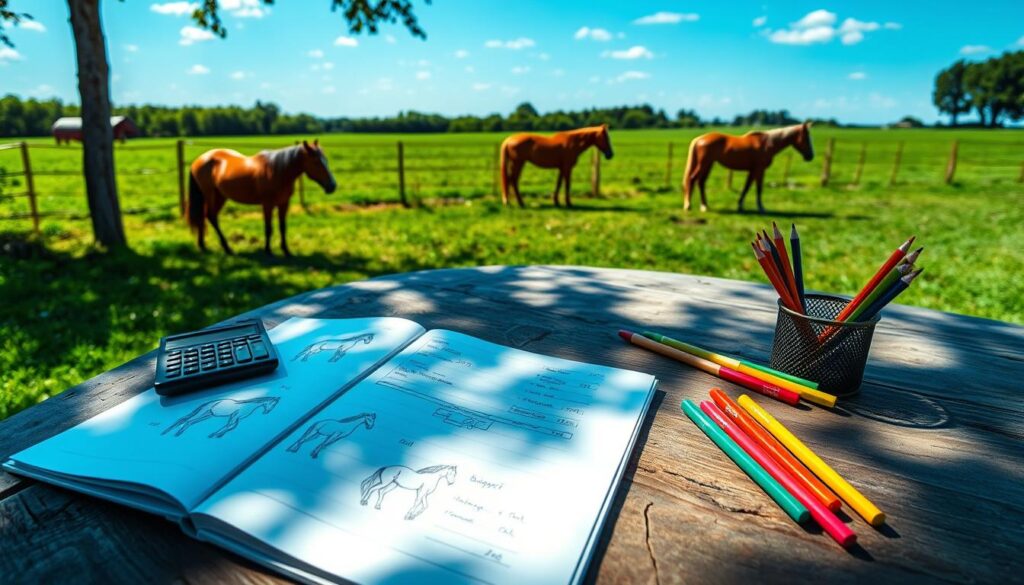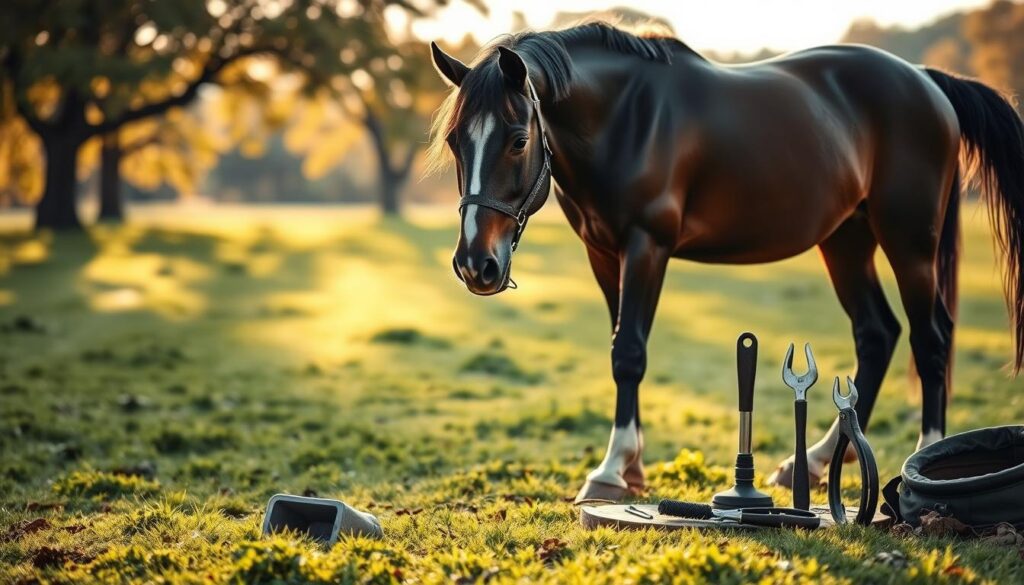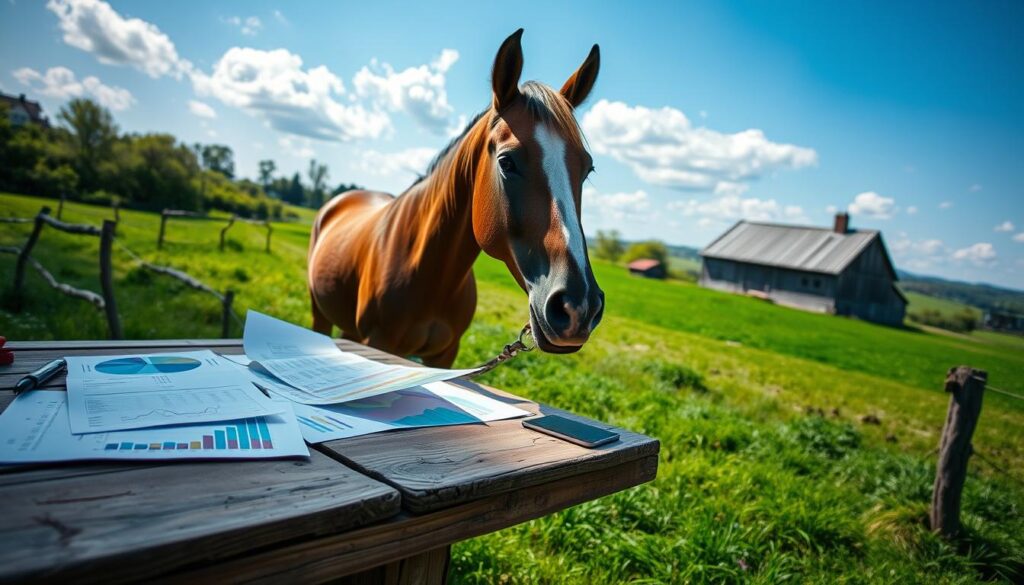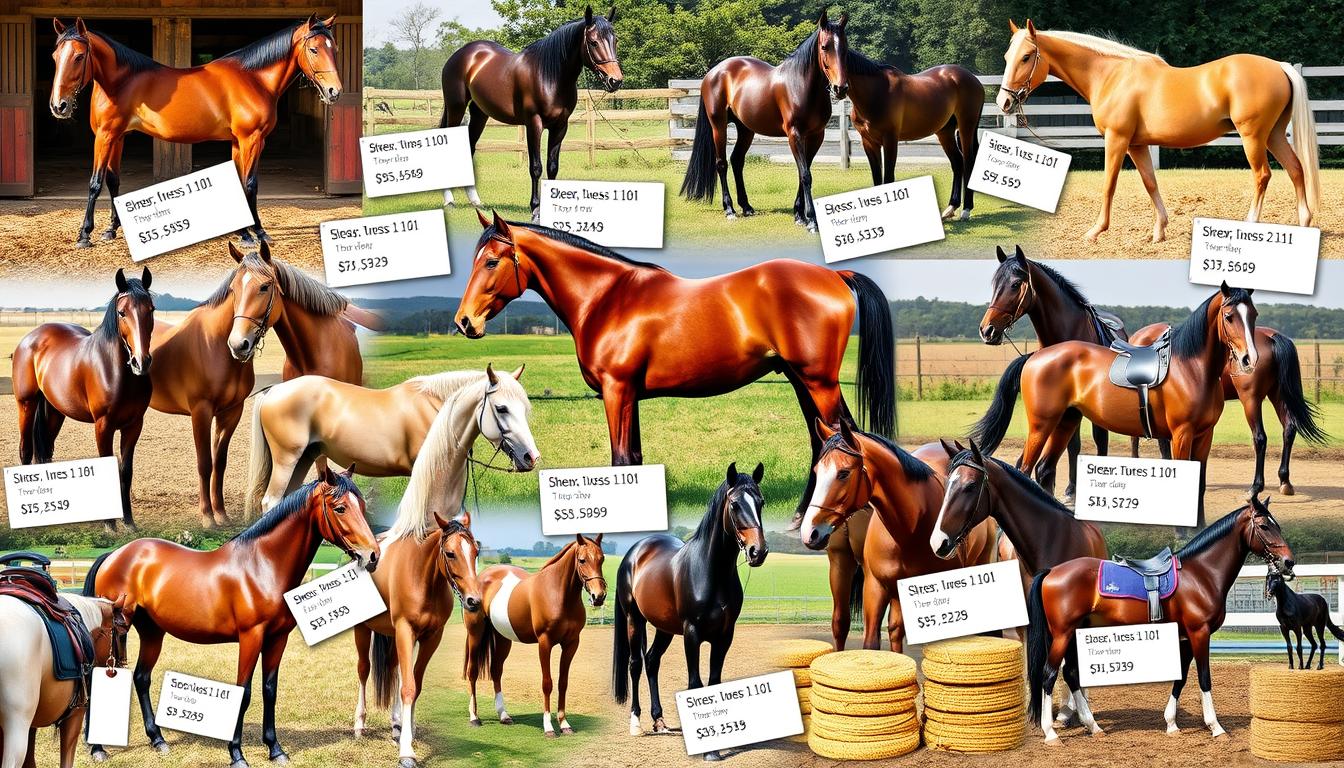Knowing the costs of owning a horse is key for anyone thinking about getting one. The cost of a horse varies based on its breed, age, and training level. In this article, we’ll explore horse prices, including the initial cost, ongoing expenses, and other costs of horse ownership.
Whether you’re an experienced horse owner or new to the scene, understanding the true cost is vital. We’ll cover everything from the initial purchase to ongoing expenses, so you know what to expect.
Key Takeaways
- Understanding the costs associated with horse ownership is crucial for making an informed decision.
- The initial purchase price of a horse depends on factors such as breed, age, and level of training.
- Ongoing expenses, including feed, veterinary care, and boarding, can add up quickly.
- Considering the true cost of horse ownership can help you plan and budget for the long-term care of your equine partner.
- Researching horse prices and understanding the factors that affect them can help you make a smart investment.
- Regular expenses, such as farrier services and dental care, should also be factored into your budget.
Understanding the True Cost of Horse Ownership
When you think about buying a horse, remember it’s not just the price. The costs of owning a horse can be high. It’s important to know all the expenses to avoid surprises.
The first cost is the horse itself. But there are many more expenses that follow. These include monthly costs like boarding and vet bills. Let’s look at the main costs of owning a horse:
- Initial purchase costs: This includes the horse’s price, plus extra costs like transport and registration.
- Monthly expenses: These are costs like boarding, food, and vet care.
- Annual cost considerations: This includes things like vaccinations, dental care, and keeping equipment in good shape.
Knowing the costs of owning a horse helps you make a smart choice. It lets you plan for the financial side of horse ownership.
How Much Does a Horse Cost to Buy?
Buying a horse is a big investment. You must think about more than just the price. Ongoing costs like feed, vet bills, and equipment are also important.
Here are some key factors to consider when determining the cost of a horse:
- Breed and bloodline: Certain breeds, such as Arabian or Thoroughbred, can be more expensive than others.
- Age and training level: Younger horses or those with minimal training may be less expensive than older, more experienced horses.
- Level of care: The cost of owning a horse also depends on the level of care you provide, including the quality of feed, veterinary care, and living conditions.
It’s crucial to research and understand the cost of owning a horse to make an informed decision when purchasing a horse. You should also consider consulting with equine experts, such as trainers or veterinarians, to get a better understanding of the costs involved.
By carefully considering these factors and doing your research, you can make a more informed decision when buying a horse. This way, you’ll be ready for the cost of owning a horse.
Factors Affecting Horse Purchase Prices
Several factors can affect the price of a horse. Knowing these factors helps you make a smart choice. The breed and bloodline of a horse greatly influence its price. Some breeds and bloodlines are more valuable than others.
The age and training level of a horse also matter. A younger, less trained horse is often cheaper than an older, more experienced one. A horse with a strong show record and performance history can cost more. This is because it has proven its ability and has great potential for the future.
Breed and Bloodline
Certain breeds, like Arabian and Thoroughbred, are prized for their athleticism and endurance. Horses from these breeds with a strong bloodline can be pricey. Prices can range from $5,000 to $50,000 or more, depending on their potential.
Age and Training Level
A horse’s age and training level affect its price. A well-trained horse with a strong competition record is more valuable. The price of a horse can vary a lot based on its age, training, and potential for growth.
Show Record and Performance History
A horse with a strong show record and performance history can cost more. This is because it has proven its ability and has great potential for the future. Horses that have competed at high levels and have a strong reputation in the equestrian community are especially valuable.
Essential Equipment and Supplies Costs
When planning your horse budget, remember to include equipment and supplies costs. These costs are vital for your horse’s health and well-being. You’ll need saddles, bridles, and grooming tools.
A good horse budget planning strategy should account for these expenses. A quality saddle can cost hundreds of dollars. Bridles range from $50 to $200. Grooming tools, like brushes and curry combs, are cheaper but still crucial.
- Saddles: $500-$1,000
- Bridles: $50-$200
- Grooming tools: $20-$50
Don’t forget to budget for replacement and maintenance costs. For example, a saddle might need re-flocking or re-upholstery every few years. This adds to the overall cost. By including these expenses in your horse budget planning, you’ll be ready for the costs of horse ownership.

Monthly Boarding Expenses
As a horse owner, one of the big horse ownership expenses is monthly boarding costs. Boarding places give horses a safe and healthy spot to stay. But, the prices can really vary based on the care and services they offer.
There are a few boarding choices out there. You can pick from full-service boarding, partial board options, or self-care boarding. Each has its own good points and downsides. The right choice for you will depend on what your horse needs, your budget, and what you like best.
When picking a boarding place, think about a few important things. Look at the quality of care, how much supervision there is, and what amenities they offer. Full-service boarding takes care of everything, like feeding, grooming, and exercise. But, partial board options might need you to do some of these tasks yourself.
Here are some key things to think about for each boarding type:
- Full-service boarding: takes care of everything, including feeding, grooming, and exercise
- Partial board options: you need to do some care tasks, like feeding or grooming
- Self-care boarding: offers a stall and basic things, but you have to take care of your horse yourself
By knowing about the different boarding choices and their costs, you can choose the best one for you and your horse. This way, you can plan your horse ownership expenses better.
Veterinary Care and Medical Expenses
As a horse owner, you must think about veterinary care and medical expenses. These costs can quickly add up. It’s important to include them in your horse investment cost. You’ll need to budget for routine care, vaccinations, and emergency procedures.
Working with a good vet is key. They can help with preventative care and spotting health issues early. Some important things to consider are:
- Regular check-ups and vaccinations to prevent diseases
- Dental care to ensure your horse’s teeth are healthy and well-maintained
- Parasite control to prevent internal and external parasites
By focusing on your horse’s health, you can lower the chance of expensive medical bills. Make sure to include these costs in your horse investment cost. This way, you’ll make a well-informed decision about your horse.
Being proactive with your horse’s health can reduce unexpected vet bills. It ensures your horse lives a long and healthy life.
Feed and Nutrition Costs
When thinking about owning a horse, remember to include feed and nutrition costs. The prices of hay, grain, and supplements can change a lot. Knowing these costs helps figure out how much does a horse cost to keep.
A good diet is key for a horse’s health. Feed and nutrition costs can be a big part of owning a horse. It’s important to pick the right feed and the right amount for your horse to save money.
Hay Expenses
Hay is a big part of a horse’s diet. Its price changes based on quality, amount, and type. A horse eats 1.5 to 2.5% of its body weight in hay each day. This can be expensive, especially for high-quality hay.
Grain and Supplements
Grain and supplements are also important for a horse’s diet. Their prices vary by type, quality, and brand. It’s smart to talk to a vet or equine nutritionist to find the best diet for your horse. This helps manage how much does a horse cost to care for.
Seasonal Feeding Adjustments
Seasonal changes can affect feed and nutrition costs. In winter, horses need more calories to stay warm, which raises feed costs. In summer, they need more water and electrolytes to stay cool, which also increases costs.
Farrier Services and Hoof Care
Regular farrier services and hoof care are key for your horse’s health. They are a big part of the average horse cost. The price can change based on where you are, the farrier’s experience, and what care your horse needs.
Finding a good farrier is important. You should research and ask for recommendations from other horse owners. A skilled farrier can prevent injuries and keep your horse healthy, which affects the average horse cost.
When picking a farrier, consider these things:
- Experience and qualifications
- Reputation and referrals
- Services offered, such as trimming and shoeing
- Cost and payment options
Regular farrier services and hoof care can prevent expensive problems later. They help keep your horse healthy and happy, which is important for the average horse cost. Remember, proper hoof care is a big part of being a responsible horse owner.

The cost of farrier services and hoof care is just one part of the average horse cost. By including these costs in your budget, you can make smart choices about your horse care. This ensures your horse gets the best life possible.
Insurance Costs for Horses
When you think about buying a horse, remember to include insurance costs. These costs change based on the horse’s value, age, and how you plan to use it. Insurance is key to protect your investment from unexpected costs or losses.
Some important insurance types to look at are:
- Mortality insurance, which covers the cost of the horse if it dies
- Medical insurance options, which help pay for vet care and other medical costs
- Liability coverage, which protects the owner if the horse causes an accident or injury
Knowing about these insurance types helps horse owners make smart choices. They can ensure they’re well-protected against unexpected expenses.
Training and Lesson Expenses
When thinking about the cost of owning a horse, remember to include training and lesson costs. These expenses change based on the training type, trainer’s skills, and how often you take lessons.
Training and lessons can be riding, horse training, or special training for jumping or dressage. Prices vary from a few hundred to thousands of dollars yearly. This depends on how often and the quality of the training.
To keep costs down, pick a skilled trainer. Here are some tips:
- Look up local trainers and their reputations
- Get recommendations from other horse owners
- Watch a training session to see if you like the trainer’s style
Quality training and lessons are key. They help your horse get the best care and attention. This also helps keep the cost of owning a horse lower over time.
Transportation and Travel Costs
When you buy a horse, remember to think about how you’ll get it home. Traveling with your horse can cost a lot, especially if you compete or travel often.
First, you need to decide on a trailer. You can buy one or rent it, based on your budget and needs. Trailers can cost from a few thousand to over $10,000, depending on size and features.
After buying a trailer, you’ll have to pay for fuel and maintenance. Fuel costs depend on how far you travel and your vehicle’s fuel efficiency. Don’t forget to budget for maintenance, like tire rotations and repairs.
Trailer Options
- Purchasing a trailer: This is a big upfront cost but lets you travel with your horse anytime.
- Renting a trailer: This is cheaper, especially if you only travel with your horse sometimes.
Thinking about transportation and travel costs helps you prepare for owning a horse. It ensures you’re ready for the expenses beyond the initial purchase price.
Emergency Fund Planning
Creating a budget for your horse is key, and planning for emergencies is a big part of it. Having money set aside can help avoid financial shocks. It ensures you can care for your horse, even when things don’t go as planned.
When planning your horse’s budget, think about emergency costs like vet bills or fixing equipment. Saving a bit each month can build an emergency fund. Regular savings are crucial for handling unexpected expenses.
Here are some tips for building an emergency fund:
- Set a goal for your emergency fund, like saving 3-6 months’ worth of expenses
- Automate your savings by setting up a monthly transfer from your checking account
- Consider opening a separate savings account just for your emergency fund
By focusing on emergency fund planning, you can feel more secure. You’ll know you’re ready to care for your horse, no matter what.

“A well-planned emergency fund is essential for any horse owner, as it can help cover unexpected expenses and ensure the continued care and well-being of your horse.”
Hidden Costs of Horse Ownership
Thinking about owning a horse means more than just the first cost and monthly fees. There are hidden costs that can surprise you. It’s key to know and plan for these expenses.
As a horse owner, you’ll need to spend time and money on property modifications. This ensures your horse is safe and happy. You might need to put up fencing, build a barn, or make a paddock.
Property Modifications
- Fencing and enclosure costs
- Barn construction or renovation expenses
- Paddock creation and maintenance costs
Also, owning a horse requires a big time investment. You’ll spend time feeding, grooming, and exercising your horse.
Time Investment
Don’t forget about unexpected repairs and maintenance. Costs like fixing fences or replacing old equipment can pop up.
Knowing these hidden costs helps you prepare for the duties and money needed to care for your horse.
Cost-Saving Strategies for Horse Owners
As a horse owner, it’s key to think about the horse investment cost. Look for ways to cut costs without losing quality. Buying hay and grain in bulk is a smart move. Also, compare prices for vet care and farrier services to find the best deals.
Try to talk down prices with trainers and boarders. Caring for your horses can be done on a budget. Caring for your horses can be done by preventing health issues. Regular vet visits and hoof care are key.
Some ways to save money include:
- Using efficient management practices like manure management and pasture rotation
- Investing in quality equipment and supplies to save money in the long run
- Learning more about horse care through workshops and resources
By using these strategies, horse owners can lower their costs. This makes caring for their horses more affordable. They can still give their horses the best care.
Budget Planning for Long-Term Horse Care
Creating a budget is key for long-term horse care. It helps owners understand the costs of owning a horse. This includes the initial purchase price, monthly boarding, veterinary care, and equipment costs. Knowing these horse prices lets owners plan a detailed budget for all horse care needs.
A good budget should have a monthly budget template for projected expenses. This includes feed, veterinary care, and equipment costs. Owners should also track annual expenses to find ways to cut costs. Regularly reviewing and updating the budget keeps it accurate and effective.
When planning a budget for long-term horse care, consider these points:
- Initial purchase costs and horse prices
- Monthly expenses, such as boarding and feed
- Annual costs, including veterinary care and equipment
- Emergency fund planning to cover unexpected expenses
By planning and managing their budget well, horse owners can give their horses the best care. They can also keep their horse ownership sustainable and financially sound.
Making an Informed Investment in Your Equine Partner
Buying a horse is a big deal that needs a lot of thought. The average horse cost and what you spend on a horse can change a lot. Knowing all the costs helps you choose wisely, fitting your lifestyle and budget.
We’ve looked at many sides of owning a horse, from the first cost to monthly and yearly expenses. Knowing all the costs, like food, vet bills, training, and travel, helps you plan a budget. This way, you’re ready for the long-term costs of caring for your horse.
The cost of owning a horse is more than just the initial price. It includes many other things to think about. Saving money for surprises helps keep your horse happy and healthy, and reduces stress for you.
Starting your horse-owning journey means putting your horse’s health, safety, and happiness first. With the right mindset and responsible care, the benefits of owning a horse can be greater than the costs. Enjoy your journey!
FAQ
Q: How much does a horse typically cost to purchase?
A: The price of a horse can vary a lot. It can be a few hundred dollars for an older horse or thousands for a top-notch show horse. The cost depends on the horse’s breed, age, training, and past performances.
Q: What are the monthly expenses associated with owning a horse?
A: Monthly costs for a horse include boarding, food, farrier services, vet care, and insurance. These can range from 0 to ,000 or more. It depends on where you live and how much care your horse needs.
Q: What are the annual cost considerations for horse ownership?
A: Horse owners also need to budget for yearly expenses like vaccinations, deworming, dental care, and new equipment. These costs can add up fast. It’s key to plan and set aside money for them.
Q: How can I save money on the cost of owning a horse?
A: To save money, consider buying in bulk, negotiating with service providers, and looking into partial board or self-care. Making a detailed budget and tracking expenses can also help you find ways to cut costs without sacrificing your horse’s care.
Q: What factors should I consider when budgeting for long-term horse care?
A: When planning for long-term care, think about the horse’s age, health, and future needs. Having a detailed monthly budget and tracking yearly expenses can help you prepare for the ongoing costs of owning a horse.

